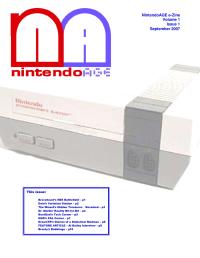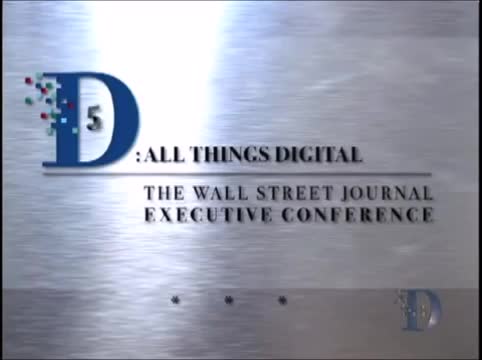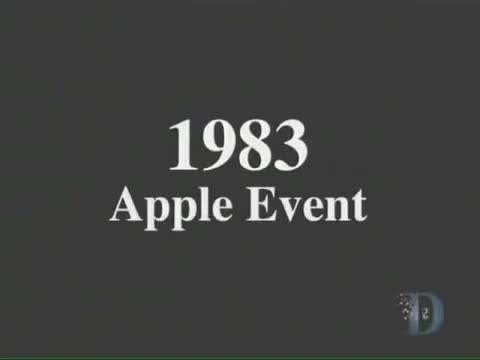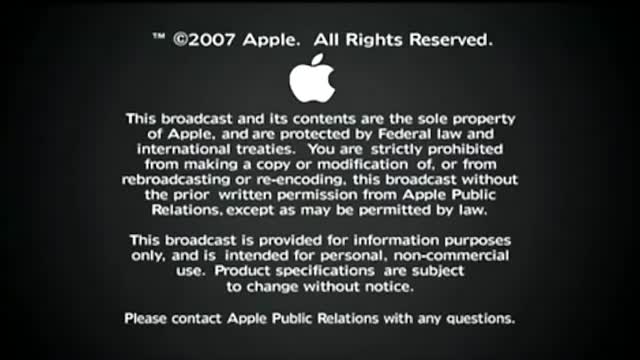NintendoAGE eZine Volume 1 Issue 2 (2007)

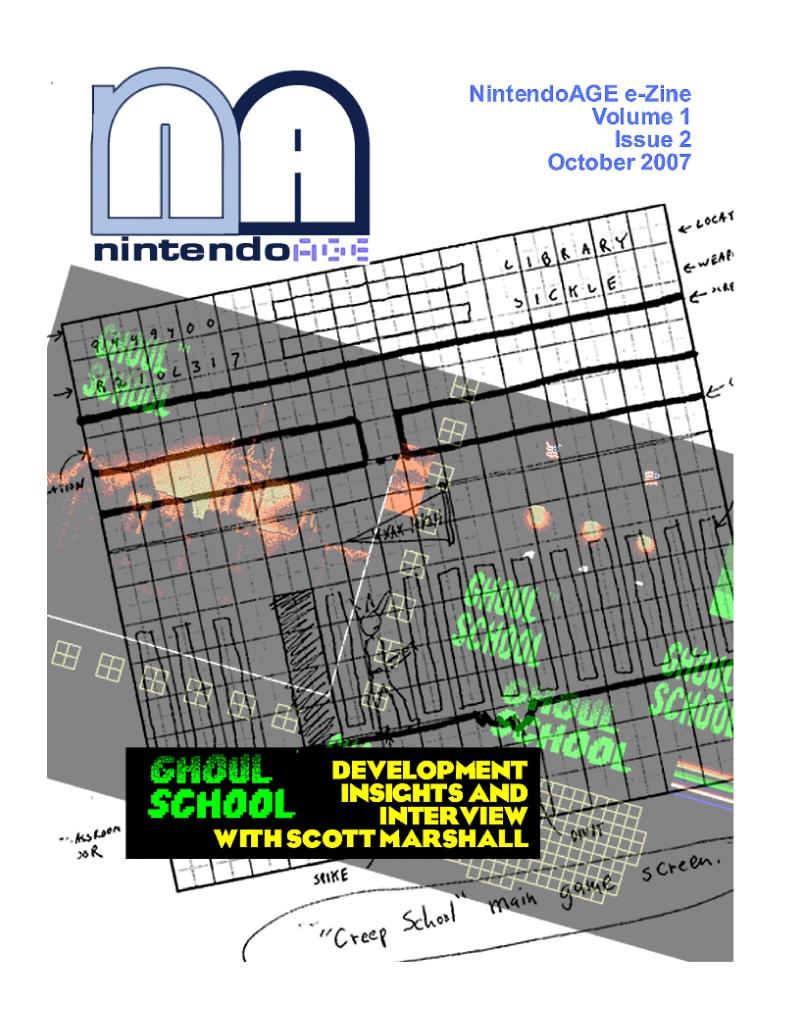
NintendoAGE eZine Volume 1 Issue 2; October 2007
Copyright 2007 NintendoAGE & Dain Anderson
All rights reserved. No portion of this document may be copied, reproduced, redistributed, hosted or sold, in part or in whole, without express written consent of NintendoAGE
Staff
- Editor-in-Chief: Dan Langevin (Dangevin)
- Executive Supervisor: Dain Anderson (Dain)
- Staff Writers: NationalGameDepot, The_Wizard_666, DreamTR, Dr. Morbis, Bootgod, Stan Stepanic
This is, and always will be a free publication available exclusively to the registered members of NintendoAGE.com
If you acquired this document from any other source pleas notify us at webmaster@nintendoage.com
A Letter from the Editor...
by Dangevin
Welcome all to Issue #2 of our fledgling Zine! There was a lot of excitement surrounding its premiere issue last month so I didn't feel that a column like this was necessary, but as this publication hits its stride, it well need a voice.
Part of that voice will be this section, in which I will describe changes, call for action on your (the reader's) behalf and remark on NintendoAGE site news in general. Speaking of site news, anticipation of the site's new version release has stil been a common theme on the message boards. I've spoken with Dain and he's assured me that the next upgrade will be a vast one with new functionality, bugfixes and updates to NES data, and also a few other "surprises!" Keep an eye out for these changes sometime this fall.
After the first issue, quite a few interesting requests were made by the readers. One simple addition I've made has been page numbering so that those who would like to print hardcopies have an easier time organizing their sheets. Another I plan to introduce with Issue #3 will be a short Q&A section, where the NintendoAGE Administration will answer selected questions. Submissions should be made in the appropriate discussion forum for each issue, and will be selected and answered by various NA staff.
This month were featuring a spectacular article by a new contributor, but long-time collector Stan Stepanic. His October. appropriate Ghoul School developer interview is timely with Halloween right around the corner. and also includes some remarkable production information seen for the first time publically in this eZine. Thanks for reading, and enjoy!
DreamTR's Diaries of a DIABOLICAL MADMAN
I’ve been playing video games in the arcade ever since I was 4 years old. In the beginning there was Pac-Man...and not much else was going on in my life. Then came Donkey Kong, Donkey Kong Jr., and other cartoony games that piqued my interest much more than popular mainstays such as Missile Command, Defender, Sinistar, and the other space-age suspects.
Being that the Nintendo Entertainment System was the only game system that resembled its arcade counterparts (and I thought it was the coolest thing since sliced bread!) I HAD to have as many games as possible for it. Being in 7th grade when Mike Tyson’s Punch Out was released and not having a copy of it that very week was a surefire blow to a kid’s ego. Only ONE kid at school had it. I begged and pleaded with that kid to let me borrow it just for one night. Forget the fact that he brought it to school (unbeknownst to his mother) to show it off to everyone, but I just HAD to be the one to ultimately wreck this kid’s week. He told me I had to return it to school the next day, but I told him I forgot it. A wrath like no other began. That poor classmate of mine was at my door crying not even two hours after school ended. I don’t remember what happened to that kid, but a week later he was not in my class, nor even in the school anymore. Poor kid. I guess from that point on I really knew that the NES was going to control me for most of my life. Little did I know, that was only the beginning.
My friend Joe and I used to play all sorts of NES games together: Pro Wrestling, Double Dribble, Bases Loaded, and Tecmo Super Bowl to name a few. He even came up with a competing magazine to Nintendo Power called “Nintendo Super Power;” action packed with all sorts of reviews of completely made up games like “Super Duper Contra,” and its many sequels including “Super Duper Truper Contra,” and “Super Duper Truper Ultra Mega Contra.”
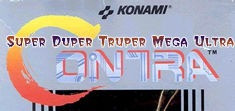
Our favorite was Konami Bowl. You would think that the best third party game company would wreck shop with a game that would put Tecmo to shame, but they just weren’t interested in it. I especially enjoyed our Mega Man 4, 5, and 6 games without even imagining that Capcom really would create Mega Man games for the NES past Mega Man 3. As the bosses became larger and larger on the screen, you had 499 bullets in your arsenal, and it required 500 bullets to defeat certain bosses with no power-ups available. What did all of this teach me? That I wanted to “steal” NES games from department stores for some reason. More on that next issue.
Ghoul School Development: Programmer Scott Marshall and Artists Jesse Kapili speak from the NES GRAVE!
by: Stan Stepanic
Being that this is my first article, I wanted to do something to impress everyone. Halloween is upon us, so I knew I needed to go for something in the horror genre. The NES had a small library of such titles, of which only one really stood out and lead to a lasting series: Castlevania. Others, like Monster Party, pretty much fell to the side and aren't even really mentioned anymore by fans. Out of these, one always touched me as being truly underappreciated. I didn't even know about it until I found it at a used music store. It's one of the least talked-about NES titles out there, and it's time to give it the attention it deserves. I'm talking, my friends, about Ghoul School. In my quest to learn about this game, I sought out the programmer, Scott Marshall, who readily agreed to answer questions about the game's history, so a big thanks to him for his help. Think you're not familiar with him? Think again, he did work on “Bart Vs The Space Mutants,” as well as the original version of Crossbow. Through him I was also able to get a few inside comments from Jesse Kapili, the original artist who worked with Scott during the creation of the game. I'd also like to thank Jonathan at Blogleech, who did an interview with Scott a little while ago. Instead of asking the same questions again, I simply asked for permission to use some of the information in this article. If you want to read the original interview with Scott on the site, it's at www.bogleech.com/article-ghoulschool.html. Either way, big thanks to all of them. Now then, love it or not, let's delve into the history of Ghoul School.
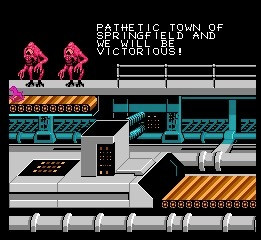
Ghoul School began as an official idea in 1989. Influenced by Night of the Living Dead, Scott conceived of a title that would combine Ghostbuster-like themes with Zelda II-styled gameplay. At the time, since the Game Boy was incredibly popular and the dominant handheld on the market, the idea was to release the game for it alone. Developers were given Game Boy systems to play, so while trying one the idea came forth that since children were playing them in school to begin with, a game somehow involving school would be a creative idea. Working for Imagineering Inc., Scott presented the idea in October of the same year, but the company decided to develop the game for the NES instead of the Game Boy. He never discovered why, nor asked, mainly because it was a step up from his original plans and he was so excited to get things underway he didn't even question the matter. With the idea up and ready, plans continued and he started to work on the creation of the game with Jesse.
Scott's original, basic write-up for the game as he presented it to the company was this: "A public high school that has been taken over by "ghouls," who have turned it into their school of ghouling, operating every aspect of it themselves in a shocking parody of real school life." Thus, ghouls take over everything and begin to pretend they're running everything as people normally would. The story in the manual is largely the same as the one for the original conception of the game so I'm not going to comment, though it should be noted that originally the main character had a crush on the school principal, who you would save at the end instead of the cheerleader character who was programmed. Scott and Jesse threw around various ideas while they were starting to create the game, drawing from old horror movies and shows. The idea of High School was considered better since it would likely seem cooler to younger children and since the majority of gamers were male a male character was selected for the role. Furthermore a rebellious type would seem more cutting edge for play, so a punk teenager was selected, and thus Spike was born. For the enemies, and here is where the game differs from what was released, Scott conceived of Spike accidentally turning his school into a school of the undead, thus primarily zombies. To make it somewhat appealing to parents so they didn't think it was an all out bloodfest, he tried to stress that Spike was saving the 'ghoul' school and turning it back into the 'cool' school so kids could start learning again. I'm not sure if that would have been enough to sway parents, but regardless of this it's quite obvious from the ending screen.
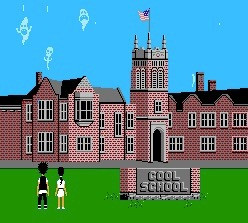
Unfortunately, the first problem was that the publisher who contracted Scott to create the game objected to the enemies being human, even though they were undead, so the original idea had to be canned. In addition, mainly due to time constraints, they all but took over the creation of the game's enemies, turning the 'ghoul' school into something more of a building inhabited by space aliens, completely ignoring his original designs. If you look back up at the picture comparison earlier, you'll see this is undoubtedly the case. Only a few undead beings still remain in the game, such as the instructor in the music room, but most were removed. Scott's original idea was also to have Spike fight various bosses in the game that were different body parts. Of these, you still have the spinal column, the heart Admiral Aorta, and a few other pieces, which were then supposed to come together in the end as a giant creature for the final boss. The disembodied legs in the gym, a head for the principal and lungs were removed, as well as zombie lunch ladies, teachers and so forth.
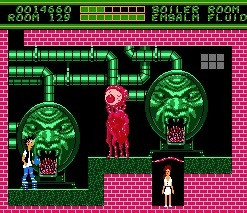
The final boss was replaced with an eyeball monster, a far cry from the giant, frankenstein-like beast he conceived. So as you can see, by the time production was well underway, the original idea was far from present.
In spite of problems with his original idea and reversal by the company to create their own enemies as they sought to make a quick dollar from the idea instead of working with it, production continued and some of the most basic aspects of Ghoul School were retained. Scott worked as the creator designing the maze, weapons and layout. Considering the popularity of Zelda II and games such as Rygar, Scott opted for Spike collecting objects and using them to progress further through the school to get to the end. Zelda II became the general concept behind the working of Ghoul School as a whole. In fact, if you pay attention to Spike's movements, they're nearly identical to Link's. Strangely, though he nearly duplicated the play control, the game received fairly low marks in this area, which says a little about one of the purposes behind Nintendo Power. Many NES fans do find the game quite difficult at times, and the redundancy of the school can sometimes make for a confusing experience, but remember, this wasn't the original intention.
Some of Scott's ideas, such as random skeletons jumping out of lockers when you wouldn't even suspect it and other features to keep the player engaged were removed due to time constraints and programming difficulties. Only a few can be found, such as Spike's ability to enter lockers to avoid enemies. But aside from this, the major mistake made was that Imagineering didn't believe in testing the game with actual children, so areas that could have been improved were not even recognized. Scott himself believes certain things should have been corrected. For example, the play control, though nearly the same as Zelda II, he felt would have been more enjoyable if it was less realistic like Super Mario Bros., where you can change direction in midair. Applying general rules of physics to movements was thought to make it more believable, but in certain respects it made Ghoul School more unplayable. The maze was extremely tedious to some players, but was never altered throughout the entire process. The only thing changed were some of the wall colors. You'll notice this occurs whenever you're in a hallway that has something interesting or necessary close by, which was only added after Scott noticed his friends started to skip doors in the hallways because they all seemed the same. Imagineering ignored such issues when they were mentioned, thinking more difficulty made for a better title, but this was obviously not the case. As for the music, it was somewhat influenced by Philip Glass, but otherwise was entirely created by Scott, though he did lift Bach's Toccata and Fugue in D Minor since these are relatively common horror music fare. When the game was nearly completed, it was then sold to Electro Brain and the manual was written by one of their in-house writers, who added to the original storyline and worked with Scott's ideas in the design of the manual. Though most of the concept had been altered beyond belief and the game was incomplete, it was set to be released.
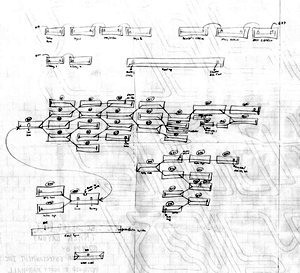
But this wasn't the end of Ghoul School's problems. Though some players may find the controls a bit difficult and some of the gameplay tedious, I rather enjoyed it and played straight through it a few days after purchase. I tend to enjoy almost any NES game I play simply due to nostalgia, but this was one game I never grew up with, and in spite of some of its flaws I found it enjoyable and a lot of fun overall. Looking around, I've even seem some pretty positive reviews on the internet. So what happened when it was released? Scott stated that he was hoping the game would lead to a cartoon series, and the ending is proof of this. Ever wonder why Samantha, after Spike has braved many dangers to save her, pushes him off and steps to the side when he puts his arm around her? The reason was that, first off, Scott wanted to go against the grain a story that followed the 'save the girl' format, but also to leave a feeling of the story being unresolved so the tension would potentially lead to further games. Thus, perhaps a sequel or even a series would have come out of it, continuing the idea and keeping the property alive. The idea of a show was mentioned to the company, but never encouraged so nothing came of it, though it probably would have been pretty interesting. But what happened to Ghoul School's release to make it sink into obscurity in spite of what are, in my opinion, some minor flaws?
Well, and let this be a lesson to fans out there who're all aware of Nintendo's horrible third-party policy. What many of us do not know, or at least only have suspicions of, is that though they licensed various companies to release games, they sometimes didn't treat them kindly, especially those that were less known. Ghoul School was originally slated for released in Christmas of 1991. Nintendo always gave priority to their own releases, not third-parties', so instead of allowing them to produce games when they wanted, they would frequently push forward release dates leaving titles like Ghoul School to be released at times way after any initial interest may have existed, frequently during months when game sales were not typically high. Nintendo, in fact, outright refused to manufacture the game so assembly lines could be used for their titles and systems. Thus, it was released several months later, in March of 1992, a time of year when I must say I don't believe many people are buying many games. A testament to this fact is that the sales were low enough that Scott never received any royalty payments for his project, and remembers that a mere 10,000 units (yes, that's total cartridges) were actually sold.
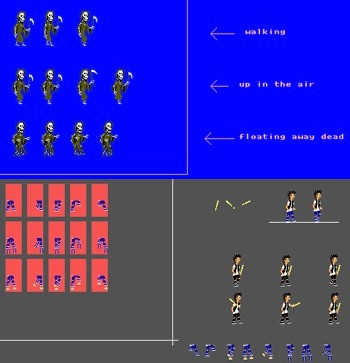
So there ended the story of Ghoul School and any potential for further games, a cartoon series or action figures. Scott began work in the computer business during production when he realized Imagineering was doing whatever they could to weasel out of paying him for the idea. By the time the game was finished, he was completely disgusted by the video game industry, continuing computer work (since it paid better) as well as performing music. It's a shame to me that great ideas like this always seem to be shot down and reduced to things way below what they could have originally been, but in this case, though the original ideas seem awesome, I have to say that I'm still happy with the end product. Difficult though it may be in certain areas and flaws though it may have, Ghoul School is a game that still deserves attention from NES fans, because it's one of the few games for the system in the horror genre and the only one of its kind that follows the Rygar format. It was a great experience speaking with him and very eye-opening on the history of the title, so I hope NintendoAGE readers enjoyed it and learned a bit about a game that no one really seems to bother with. I strongly recommend you check out the original interview for some more details on things I didn't even mention since it will give you even more insight into Ghoul School. See you next time!
PAL's Corner
By: ~~NGD
“PAL Defined”
We all see and hear “PAL” all the time, what does it mean exactly? PAL stands for Phase Alternating Line and is simply put the type of television format you use. It coordinates the color, frame-rate, and frequency on your TV with the game system to operate correctly.
So what is the difference between PAL, NTSC and SECAM? NTSC stands for National Television System Committee. SECAM stands Sequential Color with Memory. Most of the world uses PAL format, simply because PAL images tend to look sharper and have a higher resolution than the other 2. SECAM doesn’t affect the gaming community very much so I won’t get very in depth with it. PAL games operate at 625 scan- lines, with a 25 FPS frame rate, and with a frequency 50 Hz. NTSC however operates at 525 scan-lines, with a 30 FPS frame rate, and with a frequency 60 Hz.
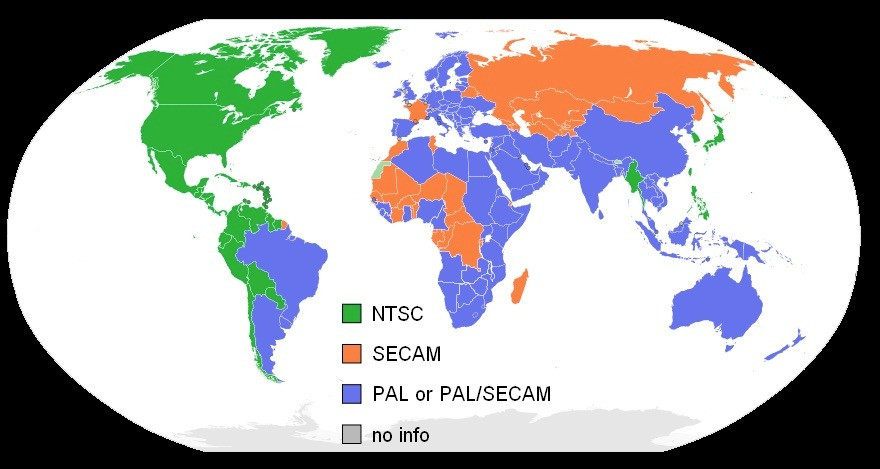
What all this really means is that most PAL games won’t properly work on a NTSC machine and vice versa. If a PAL game is played on a NTSC machine it might result in the screen rolling, the colors scheme being drastically different, different speeds of game play, or such graphical and musical glitches that the game is simply unplayable.
To break the PAL market down even further, it is broken down into 2 regions for NES collecting; PAL A and PAL B. Below is a chart of what regions fall into each category:
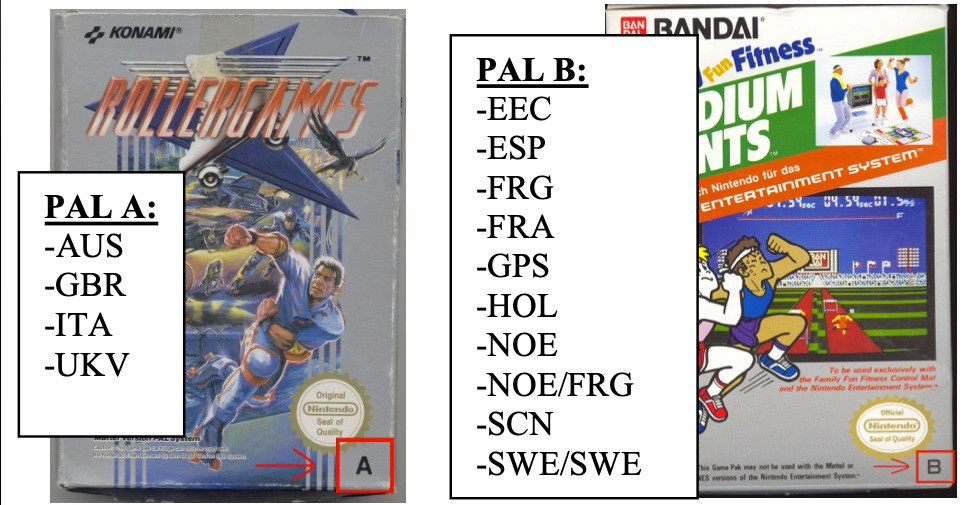
Each PAL region code can be on the front of most boxes with the large A or B (note scans above). But we don’t always have the luxury of the box to tell us whether a game is A or B so by learning the regions codes it will save yourself a lot of hassle. Some of the carts also have the A or B, but not all of them do.
The PAL & NTSC coding is controlled by the lockout system. So if you have a toaster that has had its chip clipped then it will have better functionality than a standard NES, which is why so many collectors do this. Also a good alternative is using a NES Top Loader System; they are region free and do a much better job playing PAL games for the US market. Even with using these methods, some games will not play without a PAL system. Many newer TV’s are dual region and will display both regions correctly provided they are playing on the correct system.
Some of you NTSC guys are probably thinking why would I want to collect PAL games? There is not an easy answer to that, but here are a few reasons why I collect both. First and most logically is because of the PAL exclusives like Rodland, and Mr. Gimmick. There are about 40 exclusives games that we didn’t get in the United States that our European and Australian friends did. Second, there are lots of games with different box, manual, and game art (ex. below). Some of the PAL boxes also have the infamous small box version, or the “Classic Serie” version which adds a few other small subsets to collect. Then for the hardcore variant hunters, PAL gives you an almost never ending supply of region codes to collect for making the NES collecting option available for years to come. New region codes for existing games are found fairly often and are added to the NA database on a regular basis, so you have to factor in the thrill of finding an undocumented game for the community as well.
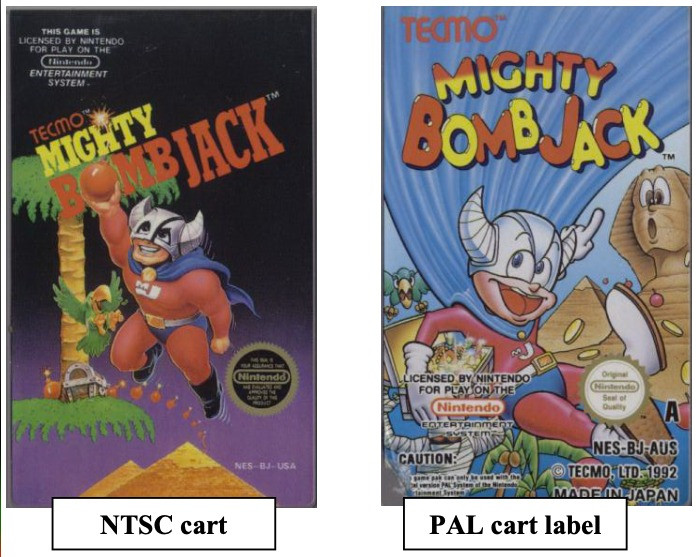
Obviously PAL collecting isn’t for everyone, but this article will give you a basic overview of what the PAL market is. This has been a very simplistic write-up on a very complicated subject so I didn’t touch on a lot of important and detailed information. I will touch on a few of the items I mentioned in the paragraph above in future PAL’s Corners articles.....so stayed tuned!!
Dain's Variation station
Three vs. Five – Which Team are YOU on?
Starting sometime in the latter part of 1987, and continuing through the early months of 1988, Nintendo adopted a new design for its Game Pak cases to utilize three screws instead of five, along with an easier-to-assemble “hinged” casing. It was also at this time they began using different security screws, making opening Game Paks a bit more tricky. For good reason, too – Nintendo was losing money.
Prior to this new design, Nintendo no doubt felt a slight pang to their bottom line when they realized just how easy it was to get ripped off by the average 9-year-old freckle-faced kid. These witty hooligans would buy a Game Pak, open it up with a flathead screwdriver, swap PCB boards with another game, and return the game for an “even exchange.” With a brand new copy of said game in-hand, either they would return the game to another store for in-store credit (towards another game) or for a full refund, depending on the store – kids knew which stores were suckers.
Over a short period, these exchanges amounted to literally truckloads of games returned to Nintendo. Kids are clever, and so is Nintendo – they fought back. This battle of silent wits brought us the most popular variations subset: the “3 vs. 5” screw Game Pak, or ‘3v5’ for short.
The Skinny – “Which should I be looking for?”
To dive into this subset is to understand that it is not only the 5-screw games that we seek, but also the 3-screw re-releases, some of which are just as tough to locate. The good news is that most of the 3v5 games are easily obtainable. The handfuls of variations that elude even the most attentive eyes of hardcore collectors are the ones you should be on the lookout for:
Rare 5-screw Games:
- Alpha Mission (r9)
- Mega Man (r10)
- Star Force (r10)
- Super Pitfall (r8)
Rare 3-screw Games:
- Donkey Kong Jr (r10)
- Gyromite (r10)
- Ninja Kid (r8)
- Soccer (r9)
- Volleyball (r9)
The chart below shows which games are rarer than others are, relatively. “Relative rarity” is how we distinguish between all of the other games in this variations subset and how rare they are, relative to one another and their frequency. If a game has a relative rarity of 1, this means that every time you find this game, you have an equal (1-to-1) chance of it being either three- screw or five-screw. If a game has a relative rarity of 5, this indicates that for every 5 encounters, 1 of them should be the rarer version. This is only an estimate, as some of the rarer variations may show up literally one out of several thousands of encounters!
| Game Title | 5 Screw | 3 Screw | Relative Rarity | Which is Rarer? |
| 10-Yard Fight | Yes | Yes | 3 | 3 Screw |
| 1942 | Yes | Yes | 5 | 5 Screw |
| 3-D Battles of World Runner | Yes | Yes | 4 | 3 Screw |
| Alpha Mission | Yes | Yes | 3 | 3 Screw |
| Arkanoid | Yes | Yes | 4 | 3 Screw |
| Athena | Yes | Yes | 5 | 3 Screw |
| Athletic World | Yes | Yes | 5 | 5 Screw |
| Balloon Fight | Yes | Yes | 3 | 3 Screw |
| Baseball | Yes | Yes | 3 | 3 Screw |
| Breakthru | Yes | Yes | 5 | 3 Screw |
| BurgerTime | Yes | Yes | 5 | 3 Screw |
| Castlevania | Yes | Yes | 7 | 3 Screw |
| Chubby Cherub | Yes | Yes | 6 | 5 Screw |
| Clu Clu Land | Yes | Yes | 4 | 5 Screw |
| Commando | Yes | Yes | 3 | 5 Screw |
| Deadly Towers | Yes | Yes | 7 | 3 Screw |
| Devil World* | No | No | n/a | n/a |
| Donkey Kong | Yes | Yes | 4 | 5 Screw |
| Donkey Kong Jr. | Yes | Yes | 4 | 5 Screw |
| Donkey Kong Jr. Math | Yes | Yes | 4 | 5 Screw |
| Donkey Kong 3 | Yes | Yes | 5 | 5 Screw |
| Double Dribble | Yes | Yes | 5 | 5 Screw |
| Duck Hunt | Yes | Yes | 3 | 3 Screw |
| Elevator Action | Yes | Yes | 5 | 5 Screw |
| Excitebike | Yes | Yes | 5 | 5 Screw |
| Ghosts 'n Goblins | Yes | Yes | 5 | 3 Screw |
| Golf | Yes | Yes | 3 | 3 Screw |
| Goonies II, The | Yes | Yes | 5 | 5 Screw |
| Gradius | Yes | Yes | 5 | 5 Screw |
| Gumshoe | Yes | Yes | 5 | 5 Screw |
| Gyromite | Yes | Yes | 5 | 5 Screw |
| Hogan's Alley | Yes | Yes | 3 | 3 Screw |
| Ice Climber | Yes | Yes | 5 | 5 Screw |
| Ikari Warriors | Yes | Yes | 6 | 5 Screw |
| Karate Champ | Yes | Yes | 3 | 3 Screw |
| Kid Icarus | Yes | Yes | 5 | 5 Screw |
| Kid Niki: Radical Ninja | Yes | Yes | 4 | 5 Screw |
| Kung Fu | Yes | Yes | 3 | 3 Screw |
| Legend of Kage, The | Yes | Yes | 4 | 5 Screw |
| Legend of Zelda, The | Yes | Yes | 10 | 5 Screw |
| Lode Runner | Yes | Yes | 5 | 5 Screw |
| Lunar Pool | Yes | Yes | 5 | 5 Screw |
| M.U.S.C.L.E. - Tag Team Match | Yes | Yes | 6 | 5 Screw |
| Mach Rider | Yes | Yes | 5 | 5 Screw |
| Mah Jong* | No | No | n/a | n/a |
| Mario Bros., The Original | Yes | Yes | 5 | 5 Screw |
| Mega Man | Yes | Yes | 5 | 5 Screw |
| Metroid | Yes | Yes | 5 | 5 Screw |
| Mighty Bombjack | Yes | Yes | 5 | 5 Screw |
| Ninja Kid | Yes | Yes | 5 | 5 Screw |
| Pinball | Yes | Yes | 3 | 3 Screw |
| Popeye | Yes | Yes | 3 | 3 Screw |
| Pro Wrestling | Yes | Yes | 3 | 3 Screw |
| Rad Racer | Yes | Yes | 2 | 3 Screw |
| Raid on Bungeling Bay | Yes | Yes | 5 | 5 Screw |
| Ring King | Yes | Yes | 5 | 5 Screw |
| Rush'n Attack | Yes | Yes | 5 | 5 Screw |
| Rygar | Yes | Yes | 5 | 5 Screw |
| Section-Z | Yes | Yes | 5 | 5 Screw |
| Sky Kid | Yes | Yes | 5 | 5 Screw |
| Slalom | Yes | Yes | 2 | 5 Screw |
| Soccer | Yes | Yes | 5 | 5 Screw |
| Solomon's Key | Yes | Yes | 5 | 5 Screw |
| Spelunker | Yes | Yes | 5 | 5 Screw |
| Spy Hunter | Yes | Yes | 5 | 5 Screw |
| Sqoon | Yes | Yes | 5 | 5 Screw |
| Stack-Up | Yes | Yes | 5 | 5 Screw |
| Star Force | Yes | Yes | 5 | 5 Screw |
| Star Voyager | Yes | Yes | 5 | 5 Screw |
| Stinger | Yes | Yes | 5 | 5 Screw |
| Super Mario Bros. | Yes | Yes | 10 | 5 Screw |
| Super Pitfall | Yes | Yes | 5 | 5 Screw |
| Tag Team Wrestling | Yes | Yes | 5 | 5 Screw |
| Tennis | Yes | Yes | 3 | 3 Screw |
| Tiger-Heli | Yes | Yes | 5 | 5 Screw |
| Top Gun | Yes | Yes | 5 | 5 Screw |
| Track & Field | Yes | Yes | 5 | 5 Screw |
| Trojan | Yes | Yes | 5 | 5 Screw |
| Urban Champion | Yes | Yes | 5 | 5 Screw |
| Volleyball | Yes | Yes | 5 | 5 Screw |
| Wild Gunman | Yes | Yes | 5 | 5 Screw |
| Winter Games | Yes | Yes | 5 | 5 Screw |
| Wizards & Warriors | Yes | Yes | 5 | 5 Screw |
| Wrecking Crew | Yes | Yes | 5 | 5 Screw |
| Zanac | Yes | Yes | 5 | 5 Screw |
* Non-US exclusives; Devil World was released exclusively in Scandinavia; Mah Jong was released exclusively in Hong Kong
The Troublemakers – “Houston, We Have a Problem!”
A small handful of games released in the timeframe one would expect to see both three and five screw releases simply do not exist (as far as we know). For lack of a better term, we will call these the troublemakers, as they do not play nicely in our anal-retentive world of collecting. The following games, in theory, should exist in both styles, but only exist in three-screw format:
- Gotcha! The Sport! (LJN)
- Jaws (LJN)
- Karate Kid, The (LJN)
- Mike Tyson's Punch-Out!! (Nintendo)
- Side Pocket (Data East)
- Stadium Events (Bandai)
Of these titles, the ones manufactured by LJN make sense as not existing, because the cases for LJN games were custom built. The remaining games are still a mystery or are unconfirmed as existing in five-screw format. Some collectors theorize that the actual release dates are incorrect by Nintendo’s account, explaining why these do not exist (they were released after the conversion timeframe).
The Technicalities – “Pfft, Who Counts Those?!”
This article would not be complete without mentioning the “other” 5-screw games that typically go unnoticed when tallying a list such as this one. The cries of injustice would ring loudly if we did not mention that some prototypes, test carts, demo carts, and the like, exist in both 3- and 5-screw format. Similarly, some games marked as non-existent in 3-screw format do in fact exist, but only in PAL or non-US regions. Donkey Kong and Donkey Kong Jr. Math – as two examples – both exist in 3-screw format in most PAL and/or non-US regions.
Updates and Discoveries
With new discoveries unearthed constantly, we have little doubt this article will be self-deprecating. As a result, we will be making addendums in future articles covering anything we missed or discover. If you have any information we failed to mention, errata, etc, please send it to editor@nintendoage.com.
Dr. Morbis' Reality: bit for bit
The truth is, we’re all living a lie. There – I said it, and no I’m not taking it back. I wish I could, but I can’t. Allow me to explain...
So we’re all on this long, winding journey: at some point in our lives, we “rediscovered” our Nintendos (for those of us who had stopped playing the things to begin with) and announced to ourselves (and perhaps also loudly to others) that we had decided to get every game. Well that’s all fine and good, and maybe even a little bit admirable, except for the fact that there’s an incurable flaw: quite simply, it cannot be done. Of course most of us didn’t realize it at the time, and some of you may still be in a state of denial (though I’ll do my best to fix that!), but the fact of the matter is that we’ve set for ourselves, as it unfortunately turns out, an utterly impossible goal.
We’ve set for ourselves, as it unfortunately turns out, an utterly impossible goal.
Now you might be thinking, “But I just collect NES and there are only so many games; even if I never end up finding the last few I need, I still know what it would take to actually get the set done.” And to that my short answer is: sorry my friend but you are horribly, horribly wrong. Let’s take a look at the particulars of the NES library, shall we? For starters, you’re going to need to get one of every title, but then what? Well, what about boxes and books and everything else that came with them? Okay, now let’s dive head-first into variants. There are major ones, but after that it gets tricky. You’ve got five versus three screw, oval seals versus round ones, numerical ID code variants, no code ID variants, Rev 0, A & B ROM revision variants, and the list goes on and on. But let’s just say that, in a lifetime of searching, you were somehow able to gather them all: every last little off-centered copyright symbol that is imperceptibly askew to the nth degree down. Now are you done? Well, what about, Sachen? (ignoring the fact that with that company, it’s almost to the point where every single cart is unique). What about Famicombox games? Supervision pirates? Euro exclusives? What about every other region? Sure, most of us grew up in North America, but we’d be fooling ourselves not to acknowledge the fact that, for every exclusive in America, Japanese gamers have three (dozen!).
Which brings us back to the source with the good old Famicom; just counting titles, there are somewhere in the neighborhood of 1253 Famicom games, which almost doubles our domestic library right there. Heaven forbid you should try to investigate further... And if in your wildest dreams you were able to accomplish all that, well then you’ve got the libraries of all other systems. I sure pity the fool who’s out to acquire “all games.” I mean, no wonder so many catch-all collectors burn out down the road – when the cold hard reality finally hits them, it must be one hell of a slap in the face.
No wonder so many catch- all collectors burn out down the road – when the cold hard reality finally hits them, it must be one hell of a slap in the face.
Now, after coming to grips with this dawning revelation, each one of us who chooses to go on collecting undaunted must be at peace with the fact that we will never accomplish our goal. And that, right there, is the paradox. Think about it: most of us are trying, right now, to do something that’s impossible, and we know it’s impossible, yet we’re trying to do it anyway, and without losing hope. Well I don’t know about you, but damn the torpedoes, I’m not giving up!
Anyway, the point of this little exercise was not to dangle your hope on a rope in the pit of despair, but to help you to come to gentle terms with this one simple truth: the enjoyment of collecting is all in the journey. Don’t worry about who has got this game or that game or how piddling your own little collection still is. Instead, look at it this way: the fewer games you have on your shelf, the more pickups you still have to enjoy down the road, and isn’t it better to have a limitless future still sprawled out before you than to be at the other end with your collection days pretty much spent? That right there is part of the reason why I’ve never understood why anyone (but a reseller) would want to buy one of those “all-in-one,” near complete collections that always pop up on eBay; it would suck away pretty much all of the fun. Seriously now, who cares about the destination? All the good times to be had come along while we’re trying to get there.
So when the time comes, many long years from now, when you are finally setting the final piece into your room of doom, finally filing that last piece of the puzzle and announcing, “Okay, that’s it; I’ve got ‘em all and I’m done,” please be sure and let me know so I can be the first to shout “bullshit.” It’ll be a nice refreshing dose of reality!
BootGod's Tech Corner
The Nintendo CIC
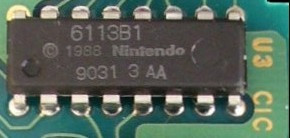
Many people are familiar with the purpose of this chip, but in case your not, let me give you a little background on the device. The CIC or “Checking Integrated Circuit” is a simple microprocessor first introduced in the NES which serves 2 purposes. First, it prevents carts made for one region from being played on a NES from a different region. Second, it prevents games not licensed by Nintendo from booting up.
Every licensed cart also has a CIC chip installed, matching the CIC in the NES for the intended region. The chip controls the reset line in the NES and failure to authenticate with the cart will cause the system to continuously reset every second or so. Most certainly you have encountered this situation at some point due to a bad connection. This authentication program executed by the CIC is said to be called “10NES”.
There are 4 primary regions and thus each one has a different CIC version:
- North America (NTSC): 3193
- Europe (PAL-B): 3195
- Asia (PAL): 3196
- Europe (PAL-A): 3197
Note that the Famicom does not use this chip, thus there is not one for NTSC Japan. This is also why NES carts have a 72-pin connector instead of a 60-pin like in Japan. The extra 12 pins are for the CIC. The CIC in NTSC carts went thru a number of revisions over the years (3193, 3193A, 6113, 6113A, 6113B1), differences unknown. For sure, they must have improved the internals of the chip as the later models operate much cooler. The 3193’s get surprisingly hot during use.
Why did they do this?
It is within reason to make sure a NTSC cart can’t be run on a PAL NES and vice-versa, simply due to the different video standards, which are not compatible. However, breaking Europe into 2 segments seems rather ridiculous and I can see no for doing this other than price control. There is no difference at all between a PAL-A and PAL-B cart besides the CIC.
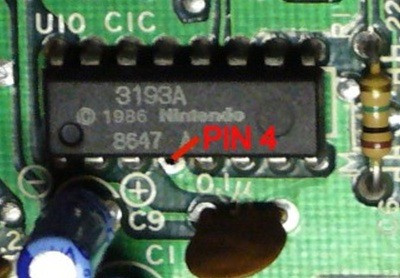
So why would Nintendo want to make sure only licensed games will work? Well, this ensures that all games have passed Nintendo’s high-quality standards and only top-notch games such as MUSCLE and Dr. Jekyll and Mr. Hyde are produced. Or maybe Nintendo just wanted their cut of a games profit!
How do I disable it?
So you live in a PAL-A region and you have a PAL-B cart that you can’t play. Maybe you can’t get some unlicensed games to work. Or maybe you just want to increase the success rate of getting all games to start up (that’s 12 less pins you need to worry about connecting after all). All of these are valid reasons for wanting to disable the CIC, and fortunately it is quite easy.
It’s been a long, well-known fact that you can simply cut pin 4 of the CIC in the NES to disable it. I’ve marked pin 4 in this photo in case you’re not sure. A very small wire-snips or an exact-o knife will work well for this.
“What about those weird blue carts?”
So maybe your wondering how companies like Color Dreams, AVE, Tengen, etc. managed to get their games to work, being unlicensed and all? Hold that thought. If you read Nintendo Power as a kid, you may recall seeing this warning:
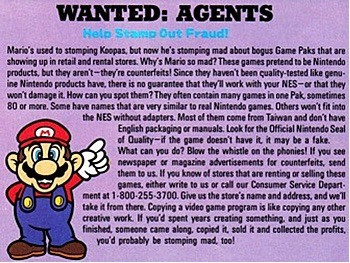
Well it turns out they weren’t just making up the part about them damaging your NES! All the unlicensed companies (except for Tengen) used the same basic principle to bypass the CIC. How it works is that the cart charges up a capacitor with a negative voltage source, typically about -5V, and then pumps this into the CIC, overloading and “stunning” the chip! Basically it is causing the CIC to crash and the system then stays in a non-reseting, usable state. Of course this is not overly healthy to your system and if the CIC is rapidly subjected to this voltage spike (for instance, while trying over and over to get a dirty cart to work), you could in fact fry the chip, causing permanent damage. This is why some had a warning asking you to wait X number of seconds between each power cycle. Camerica carts have a switch on the back that turns the “stun” circuitry on and off.
Eventually Nintendo caught on to this trick and installed protection around the CIC in later models, in which case these games that rely on this method will not work. The top-loader version of the NES, for some reason, no longer used the CIC, which is why unlicensed games work just fine on this system. For Camerica games, make sure you have the switch turned off – the “B” position - when playing on a top-loader! Trust me! ;)
So what about Tengen? Well they had the ultimate solution, a clone of the CIC! This story is pretty well-known so I won’t go into too much detail. The gist of it is that they managed to gain access to non-public patent documents of the CIC which in turn gave them the info they needed to create their own version, which they called the “Rabbit”. They were subsequently sued by Nintendo, in which Tengen lost, and that was basically the end of them. Almost 20 years later, the “Rabbit” was used to make an important break-thru!
The CIClone
In late 2006, after examining photos of the insides of Tengen’s chip taken by a microscope, it was discovered that the “Rabbit” had a special built-in test mode which allowed access to the internal state of the device! Once this was discovered, it was only a matter of days until the workings of the chip were completely reverse engineered! This led on to the birth of the “CIClone” shortly thereafter.
By early 2007, finally it became possible to produce custom carts without the need to butcher another cart for parts! Already there have been a number of successful products that utilize the CIClone: The NWC Reproduction, Sudoku 2007, and the PowerPak. And let’s not forget that many reproduction carts can now be built without the need of a donor cart! Just think of the hundreds of carts that have been spared certain death from these few products alone!
The Wizard's Hidden Treasure REVISED
Searching for the Lost Jewels of the NES
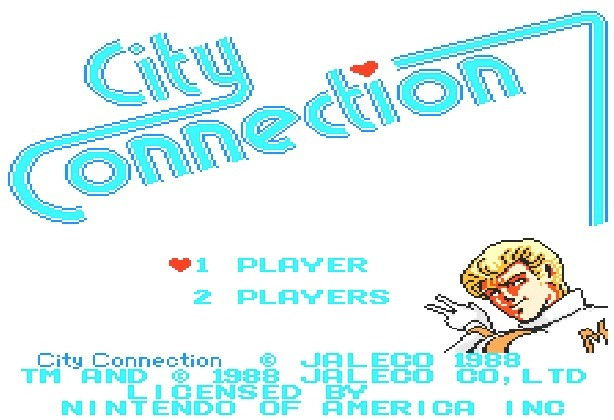
Welcome to another installment of Hidden Treasures: Revealed, the column dedicated to showing you the games that you may have overlooked. This month’s game is one of my childhood favorites, City Connection. The story is absolute cheese. Apparently, you just committed a robbery at, of all things, a paint store! I’m not kidding – check the manual! Anyway, you must elude the police and a flag waving cat, leaking paint all the while, until you’ve covered every stretch of highway in order to move on to the next city. Cheeseball, eh! Anyway, this is the type of game where the story isn’t important, so lets discuss the more important aspects of the game, shall we...
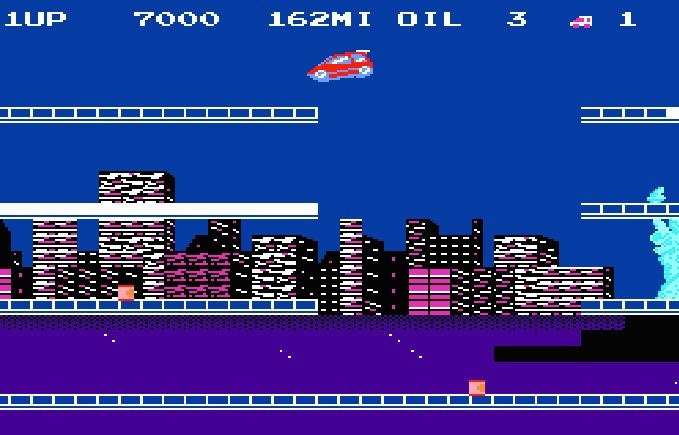
GRAPHICS: All I have to say here is...wow. 1988 isn’t known for being full of graphical goodness, but here we are. City Connection stands out as one of the best looking titles of the early NES days. Those backgrounds are gorgeous!
Sprites are very well detailed, and even the cheap-looking stuff like the oil cans, which could have simply been plain boxes on screen, have detail. The only gripe I have is that the roads don’t really stand out from the background on a couple levels – On all levels, the road is the same color as the sky, with a white grid over it. This poses some issues when the sky is a light color and the ground fails to stand out from it, but this is a fairly minor gripe.
SOUND: City Connection boasts some of the best tunes on the NES. Not “best tunes...for a Jaleco title” or “best tunes...for a 1988 release.” Despite the relatively early release and somewhat tinny sound, the songs are quality...although you’ll definitely get sick of hearing the “hit the cat” song...not because it’s bad, but because you’ll come to hate that cat as much as I do. As for the sound effects, they do their job, from the “I shot the sheriff” sound that the cop cars make when you hit them with an oil can, to the sound you make when you crash. All in all, some high quality sounds are packed into this 19 year old title.
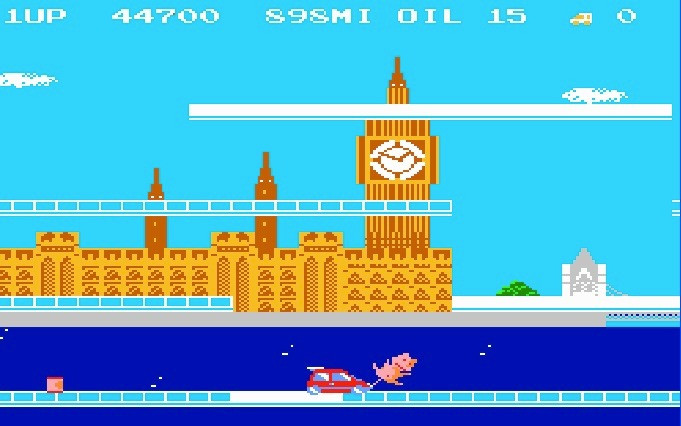
GAMEPLAY: Simple, yet addictive gameplay has kept me playing this game since my best friend (at the time) got his copy in 1990. We would literally play it until the wee hours, always cursing the damn cat, but never getting bored. Controls can be a bit stiff at times, but it doesn’t mar the experience.
OVERALL: Truly, City Connection is one of the best games you’ve never played. Chances are, it’s sitting right there on the shelf with the rest of your collection, gathering dust. If you have a copy, pop it in. If you don’t, chances are you can find one for cheap the next time you go to the flea market. It’s not Mario or Zelda, so most dealers probably won’t tag it for more than $5, and you’ll definitely get your money’s worth for that price!









